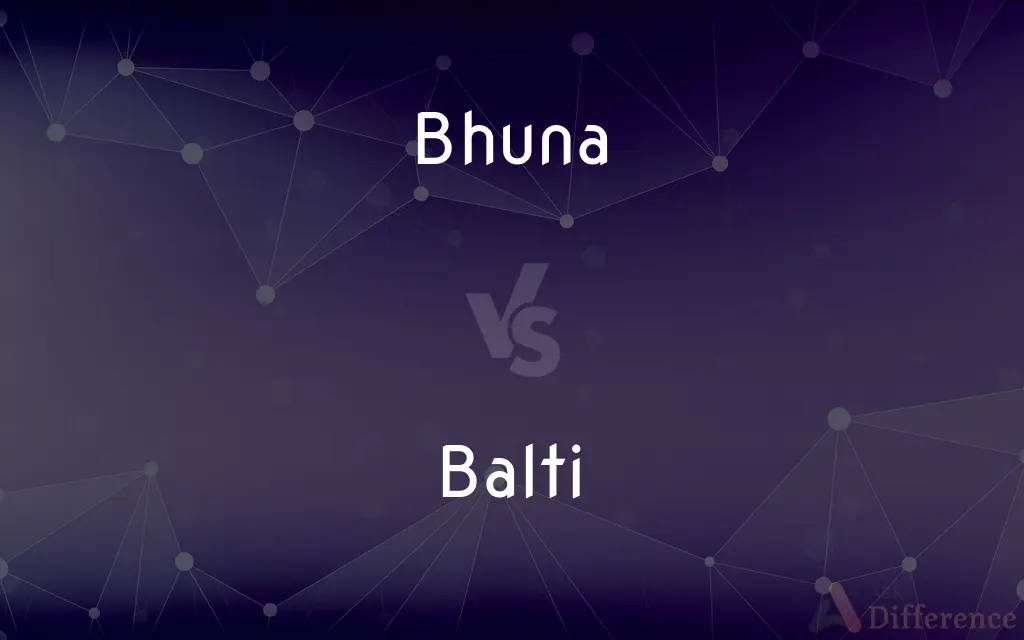Bhuna vs. Balti — What's the Difference?
Edited by Tayyaba Rehman — By Fiza Rafique — Updated on April 7, 2024
Bhuna is cooking process where spices are fried until they release their flavor, often resulting in a thick sauce, whereas Balti refers to a type of curry cooked and served in a thin, pressed-steel wok-like pot, characterized by its rich, aromatic sauce.

Difference Between Bhuna and Balti
Table of Contents
ADVERTISEMENT
Key Differences
Bhuna involves a technique central to many Indian dishes, where spices and ingredients are pan-fried with little liquid, allowing them to cook in their own juices and intensify in flavor. This method typically results in a dish with a reduced, thick sauce that clings to the meat or vegetables. On the other hand, Balti cuisine, originating from the Birmingham area in the UK, emphasizes the use of a special thin steel or iron pot to cook a curry rapidly over high heat, combining meat and vegetables with freshly ground spices and often served with naan bread for scooping.
While Bhuna is considered a cooking technique and also a dish name in Indian cuisine, emphasizing the dry roasting of spices to bring out depth and complexity of flavors, Balti, conversely, is recognized for its distinct cooking vessel and the unique method of preparation that lends the curry a robust and aromatic appeal. Balti dishes are known for their quick cooking process, which is said to retain the flavors and nutrients of the ingredients more effectively.
The spices used in Bhuna are generally ground and then fried in oil to release their essential oils, making the dish rich in flavor with a slightly thick sauce. Balti dishes, however, may use a similar range of spices but are distinct in their preparation, often involving the rapid frying of spices and ingredients together, which creates a harmonious blend of flavors that is both intense and fragrant.
Bhuna typically focuses on the caramelization of onions, which are a key ingredient, along with meat or vegetables, resulting in a dish that has a greater depth of flavor and a pronounced spice profile. Balti, while also flavorful, aims to bring out a fresh and vibrant taste, often incorporating ingredients like bell peppers and tomatoes, which add a distinctive taste and texture to the final dish.
Culturally, Bhuna dishes are a staple in various regions of India, reflecting the traditional cooking practices and regional flavor profiles. Balti, by contrast, has become a beloved part of British cuisine, symbolizing the fusion of English and South Asian culinary traditions. It caters to a palette that appreciates the melding of complex spices with a focus on convenience and speed of cooking, suitable for the bustling lifestyle of its originating region.
ADVERTISEMENT
Comparison Chart
Origin
Indian cuisine
British (Birmingham area) cuisine
Cooking Technique
Pan-frying spices and ingredients until they release their juices and become thick.
Rapid cooking in a special wok-like pot, emphasizing high heat and quick preparation.
Sauce Texture
Thick, clinging to the meat or vegetables.
Rich, aromatic, but more liquid than Bhuna.
Spices
Dry roasted and then cooked with minimal water.
Freshly ground and cooked rapidly with ingredients.
Serving Tradition
Typically served with rice or Indian breads.
Often served directly in the Balti pot with naan bread.
Compare with Definitions
Bhuna
Traditionally served in Indian cuisine.
For dinner, we had a bhuna dish that perfectly showcased traditional Indian cooking techniques.
Balti
Originated from Birmingham, UK, blending English and South Asian culinary traditions.
Balti cuisine represents a unique fusion that has become a staple in British restaurants.
Bhuna
A cooking process and dish where spices are fried to release flavor, creating a thick sauce.
The chicken bhuna featured a perfectly reduced sauce brimming with spices.
Balti
Features a combination of meat and vegetables with vibrant spices.
Our vegetable balti was a colorful mix of fresh ingredients and bold spices.
Bhuna
Characterized by the frying of spices and ingredients until dry.
Bhuna technique enhances the lamb's flavor by allowing it to simmer in its own juices.
Balti
A type of curry cooked in a steel or iron pot, emphasizing a quick, high-heat method.
The chicken balti was remarkably aromatic, served straight from the pot.
Bhuna
Focuses on caramelization and reduction.
The slow-cooked bhuna maximized the caramelization of onions, enriching the overall taste.
Balti
Known for its quick cooking and fresh flavors.
The shrimp balti, with its quick preparation, preserved the seafood's delicate flavor.
Bhuna
Known for its rich, concentrated sauce.
The bhuna curry offered a compelling depth of flavor with its thick, spice-laden sauce.
Balti
Served with naan bread for scooping.
The freshly baked naan complemented the balti's rich sauce perfectly.
Bhuna
A type of curry, in which the onions and spices are cooked in oil with no water
Balti
(uncountable) A style of Pakistani cooking in which the food is cooked in an iron pan having two handles.
Balti
(countable) A dish cooked in this style.
Common Curiosities
What distinguishes Bhuna from Balti?
Bhuna is a technique and dish known for its thick sauce and concentrated flavors, while Balti is a curry cooked quickly in a specific pot, known for its aromatic and slightly more liquid sauce.
Is Bhuna always spicy?
While often rich in spices, the heat level of Bhuna can vary depending on the recipe and personal preference.
Can Bhuna be made without meat?
Absolutely, Bhuna can be made with a range of ingredients including vegetables, paneer, or legumes.
Why is Balti served in the pot it's cooked in?
Serving Balti in its cooking pot keeps the curry warm and enhances its presentation, reflecting the dish’s casual and communal dining style.
Can Bhuna and Balti use the same spices?
Yes, both can use similar spices but differ in their preparation methods, affecting the final flavor profile.
How do the cooking times compare between Bhuna and Balti?
Bhuna typically involves longer cooking times to reduce the sauce, whereas Balti is cooked quickly over high heat.
What kind of pot is used for cooking Balti?
A Balti is cooked in a thin, pressed-steel wok-like vessel known as a "balti bowl."
Can vegetables be the main ingredient in Bhuna or Balti?
Yes, both Bhuna and Balti can be prepared with a variety of main ingredients, including vegetables, making them versatile dishes.
How does the thickness of the sauce in Bhuna and Balti dishes affect their serving suggestions?
The thicker sauce of Bhuna is well-suited for rice, while the slightly more liquid sauce of Balti pairs excellently with naan for dipping and scooping.
Is Balti considered a traditional Indian dish?
Balti, as known today, is more a product of British culinary innovation, inspired by South Asian cuisine but developed in the UK.
Is it necessary to serve Balti with naan?
While traditionally served with naan for scooping, Balti can also be enjoyed with other breads or rice, depending on personal preference.
Share Your Discovery

Previous Comparison
Meal vs. Breakfast
Next Comparison
Beamer vs. ProjectorAuthor Spotlight
Written by
Fiza RafiqueFiza Rafique is a skilled content writer at AskDifference.com, where she meticulously refines and enhances written pieces. Drawing from her vast editorial expertise, Fiza ensures clarity, accuracy, and precision in every article. Passionate about language, she continually seeks to elevate the quality of content for readers worldwide.
Edited by
Tayyaba RehmanTayyaba Rehman is a distinguished writer, currently serving as a primary contributor to askdifference.com. As a researcher in semantics and etymology, Tayyaba's passion for the complexity of languages and their distinctions has found a perfect home on the platform. Tayyaba delves into the intricacies of language, distinguishing between commonly confused words and phrases, thereby providing clarity for readers worldwide.













































